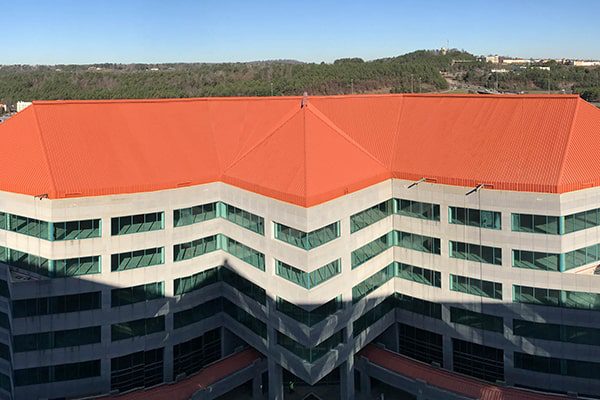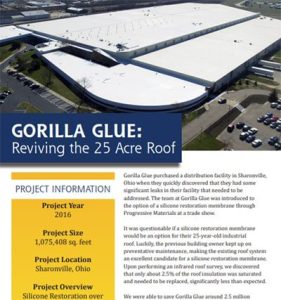Summary: If you have a large EPDM roof and you have significant leaking, what roof repair options do you have? You may think that the only option is to perform a complete roof replacement? But did you know that you can restore your EPDM roof, stop all leaks, and get the roof under a new 5–20-year warranty for about 50% of the cost? Learn how this works (along with a case study) in this article.
Let’s say that you have a large EPDM roof. And when I mean large, I mean your roof is about 1 million square feet.
And…it’s leaking.
You may think your only option is to completely rip off the EPDM roof and install a new one.
Here are some quick stats for you:
- The cost to remove an existing EPDM roof costs around $1 – $4 per square foot.
- The cost to install a new EPDM roof system costs around $5 – $10 per square foot.
Let’s take the average of the numbers above, which would be about $2.50 to remove the roof and about $7.50 to install.
Together, you’re looking at around $10 per square foot to remove and replace an existing EPDM roof.
$10 per square foot x 1 million square feet is (fierce gasp) …10 million dollars!
Now, some factors that affect the price, such as:
- How large is the roof? For economies of scale purposes.
- How difficult will the project be? Are there lots of penetrations or is it mostly all flat?
- How thick are the EPDM sheets that you’re installing?
- What type of insulation is going to be installed?
There are lots of variables when talking about the price of a commercial roofing system.
One cost-effective option that isn’t discussed regularly is roof restoration. Meaning instead of ripping the entire roof off, you can restore what’s already there.
The process has many different names in the industry, such as
- Silicone Restoration Membrane
- SRM
- Silicone Roof Coating System
- Or simply, Roof Coatings
But they all mean the same thing.
Let’s get into how silicone roof coatings work and how it’s cost-effective.
Why is a silicone roof coating system cost-effective?
There are two main reasons that silicone roof coatings are cost-effective: they require a minimal amount of tear-off and reduce future energy costs.
#1 – Minimize the amount of tear-off.
The only areas of the existing EPDM roof that need to be removed and replaced are the areas that are holding water.
Not on top of the roof membrane (that you can see), but below in the insulation.
If there’s water in the insulation, water has an entry point into your roofing system, which needs to be fixed.
Since these areas are hard to locate, a roofing contractor will pull core samples and/or perform an infrared inspection.
Once these areas are identified and repaired, the next step of the coating process can begin.
NOTE: In some cases, only a small percentage (2.5% to 20%) of an existing roof is saturated…so why pay to remove and replace 100% of it?

#2 – Reduces energy costs.
Most EPDM roofs are dark in color, which absorbs UV rays and gets very hot in the Summer.
A hot roof = hot temperatures inside the building.
Hot temperatures inside the building = HVAC unit works overtime to keep the building cool.
A silicone roof coating can be any color, but most building owners choose white for the reflectivity.
The amount of future energy savings varies depending on:
- How efficient your HVAC unit(s) are?
- What operations happen inside the building?
- What climate your building is in?
A black EPDM roof that gets a while silicone coating system can expect energy savings from 15-30%.
You may be thinking “If anyone had an EPDM roof that’s leaking, a complete roof replacement wouldn’t even be an option. I would lean towards restoration for sure.”
My counter to you is, sometimes it’s not beneficial to the building owner to restore. Sometimes it’s best to perform a complete roof removal and replacement.
Let’s talk about this for a minute.
What makes a commercial EPDM roof a good candidate for restoration?
Three factors determine whether a roof is in good shape to restore, or if it’s beneficial to remove the entire roof and start over.
Factor #1 – Less than 25% of the entire roof’s insulation is saturated.
If there’s more than 25% saturation, the roof is in pretty bad shape. It may be better to replace the entire roof than to restore it.
Factor #2 – The roof has been inspected/maintained at least annually.
A neglected roof usually has excessive amounts of saturation. A common example is when an EPDM roof gets a small hole.
If someone were inspecting the roof, they would notice the hole and make an immediate repair. When the hole is left alone for years, water has been entering that hole for years and saturating the insulation below.
The insulation used in single-ply roofing is not closed-cell, meaning the water can travel horizontally, saturating other areas of the insulation.
Long story short, a small hole (if left alone for years) can lead to a very large area of saturated insulation.
Factor #3 – The seams are still attached.
When a roofing contractor gets onto an EPDM roof and notices areas where the seams aren’t attached, it’s a red flag for restoration.
It’s the same scenario as above.
When water has an opening, it spreads and saturates large areas of insulation.
NOTE: No solution is concrete. To determine the best solution for your individual problem, it’s always a good idea to get a roofing contractor on your roof.
How much does a silicone roof restoration cost?
A silicone restoration system usually costs between $3.50 and $7 per square foot. There are many variables to the cost of a roof restoration, such as:
- How much of the roof will need to be removed and replaced?
- How long of a warranty do you desire?
- How large is your roof (economies of scale)?
NOTE: $3.50 – $7 sounds a lot better than $10 for a complete roof replacement.
Now…how about that case study?
Case Study: Gorilla Glue

Now that you know restoring your EPDM roof is more cost-effective than performing a complete roof replacement, what are your next steps?
You might be wondering how it’s applied?
You didn’t think we just threw silicone coating on your roof like it’s paint, let it dry, and it’s done?
There’s a lot that goes into it.
Here’s a link to a case study of a silicone roof restoration at Gorilla Glue in Sharonville, Ohio.
The roof was over 1 million square feet. Choosing a silicone roof coating system versus a complete roof replacement saved Gorilla Glue around 2.5M dollars!

